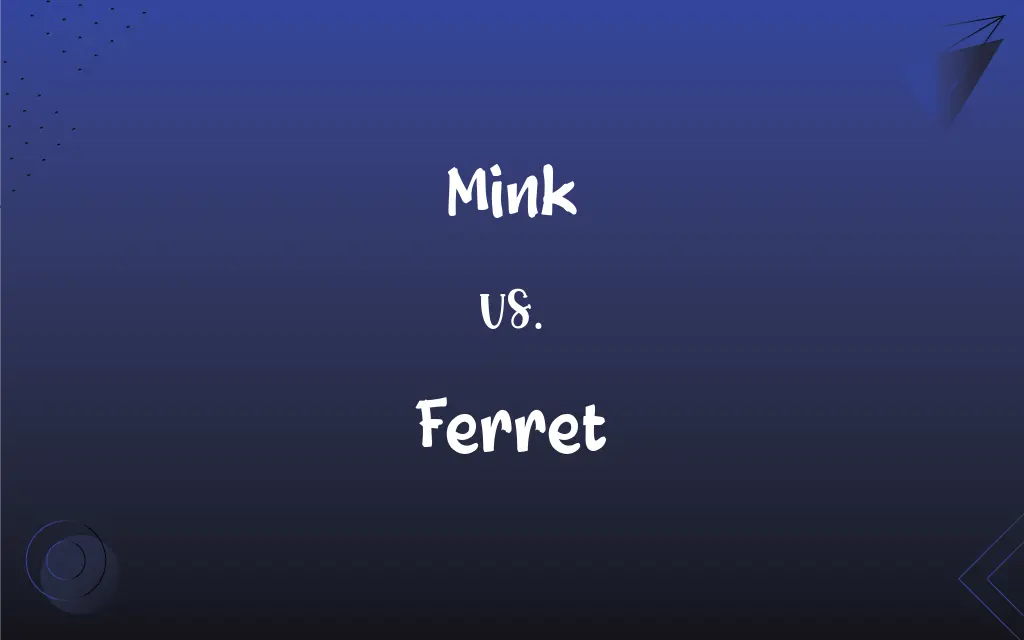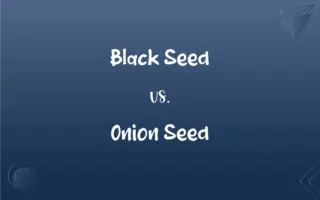Mink vs. Ferret: What's the Difference?
Edited by Aimie Carlson || By Harlon Moss || Published on March 5, 2024
Minks are semi-aquatic, fur-bearing mammals, often farmed for their fur, while ferrets are domesticated animals, related to polecats, commonly kept as pets.

Key Differences
Minks, belonging to the family Mustelidae, are known for their luxurious fur, making them a prime target for fur farming. They are semi-aquatic and thrive in water-rich environments. Ferrets, on the other hand, are domesticated animals, closely related to the European polecat. They have been kept as pets for centuries and are known for their playful and curious nature.
A mink's diet mainly consists of fish, amphibians, and other aquatic life, reflecting their adaptation to water environments. Their bodies are streamlined for swimming, with a thick, water-resistant coat. Ferrets, being domesticated animals, have a diet that is primarily carnivorous, requiring a high protein intake, usually from commercially prepared ferret food.
Minks are solitary creatures, preferring to live and hunt alone, which is a trait common in wild animals. They are also territorial and mark their areas with a strong scent. Ferrets, in contrast, are social animals and enjoy the company of humans and other ferrets. They are playful and active, often engaging in entertaining antics that endear them to their owners.
In terms of habitat, minks are found in the wild across North America and parts of Europe. They adapt well to various environments but prefer areas close to water bodies. Ferrets are not found in the wild; they are domesticated animals and require human care. They thrive in a home environment where they can be given adequate space to play and interact.
The lifespan of a mink in the wild is typically around 3 years, though this can extend longer in captivity. They face numerous threats in the wild, including hunting and habitat loss. Ferrets, being domesticated, have a lifespan of 6 to 10 years when cared for properly, with their well-being heavily dependent on human care and environment.
ADVERTISEMENT
Comparison Chart
Natural Habitat
Near water bodies, in the wild
Domesticated, in human care
Diet
Fish, amphibians, aquatic life
Primarily carnivorous, commercial food
Social Behavior
Solitary, territorial
Social, enjoys human and ferret companions
Physical Adaptation
Streamlined for swimming, thick fur
Suited for domestic life, playful
Lifespan
Around 3 years in wild, longer in captivity
6-10 years with proper care
ADVERTISEMENT
Mink and Ferret Definitions
Mink
Known for luxurious, dense fur.
Mink coats are prized for their soft and warm fur.
Ferret
A domesticated, small carnivorous mammal.
Our pet ferret loves to play in the living room.
Mink
Native to North America and parts of Europe.
We spotted a mink in the wild during our trip to the European forest.
Ferret
Playful and social pet.
My ferret enjoys playing with toys and interacting with people.
Mink
A semi-aquatic, fur-bearing mammal.
The mink by the river was hunting for fish.
Ferret
Related to the European polecat.
Ferrets, although domesticated, share characteristics with wild polecats.
Mink
Solitary and territorial in nature.
The mink we saw kept its distance, marking its territory.
Ferret
Has a lifespan of 6 to 10 years with proper care.
Our family's ferret lived healthily for 8 years with good care.
Mink
Often farmed for its fur.
The mink farm we visited specialized in sustainable fur production.
Ferret
Requires a diet high in protein.
We feed our ferret a special diet to meet its high protein needs.
Mink
Either of two semiaquatic mustelid carnivores, Mustela lutreola of Europe or Neovison vison of North America, having a pointed snout, short legs, and partly webbed toes. The North American species is bred for its commercially valuable fur.
Ferret
A domesticated mustelid mammal (Mustela furo syn. Mustela putorius subsp. furo) with an elongated flexible body, often kept as a pet and sometimes trained to hunt rats or rabbits.
FAQs
Can minks be domesticated?
Minks are generally wild animals and are not typically domesticated like ferrets.
Are minks solitary animals?
Yes, minks are solitary and territorial in nature.
What is a mink?
A mink is a semi-aquatic, fur-bearing mammal known for its dense, luxurious fur.
Are ferrets related to minks?
Ferrets and minks are both part of the Mustelidae family but are different species.
What do ferrets eat?
Ferrets require a diet high in protein, usually from commercial ferret food.
What is a ferret?
A ferret is a domesticated, small carnivorous mammal, often kept as a pet.
What do minks eat?
Minks primarily eat fish, amphibians, and other aquatic life.
Can ferrets be kept as pets?
Yes, ferrets are popular pets known for their playful and social nature.
How long do minks live?
Minks live for about 3 years in the wild, but can live longer in captivity.
Do minks hibernate?
Minks do not hibernate; they remain active throughout the year.
Are minks used for their fur?
Yes, minks are often farmed for their luxurious fur.
Are minks aggressive?
Minks can be aggressive, especially when defending their territory.
Can minks be found in urban areas?
Minks are sometimes found in urban areas near water sources.
Do ferrets have a natural predator?
In the wild, ferrets, like polecats, would have predators, but domestic ferrets are generally safe from predators in a home environment.
How long do ferrets live?
With proper care, ferrets can live between 6 to 10 years.
Is it legal to own a mink or ferret?
The legality of owning a mink varies by region and is often restricted, while ferrets are legal to own as pets in many places, though local regulations may apply.
Do ferrets require special care?
Ferrets need a safe environment, proper diet, and social interaction for their well-being.
Are ferrets good with children?
Ferrets can be good with children if properly supervised and socialized.
Do minks live in water?
Minks are semi-aquatic and thrive in environments near water.
Can ferrets be trained?
Yes, ferrets can be trained to do simple tricks and use a litter box.
About Author
Written by
Harlon MossHarlon is a seasoned quality moderator and accomplished content writer for Difference Wiki. An alumnus of the prestigious University of California, he earned his degree in Computer Science. Leveraging his academic background, Harlon brings a meticulous and informed perspective to his work, ensuring content accuracy and excellence.
Edited by
Aimie CarlsonAimie Carlson, holding a master's degree in English literature, is a fervent English language enthusiast. She lends her writing talents to Difference Wiki, a prominent website that specializes in comparisons, offering readers insightful analyses that both captivate and inform.






































































